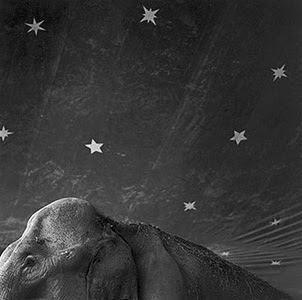



Joseph Elmer Yoakum (February 20, 1890-December 25, 1972) was a self-taught artist of African-American and Native American descent who drew landscapes in a unique and highly individual style. He was 76 when he started to record his memories in the form of imaginary landscapes, and he produced over 2000 drawings during the last decade of his life. His work is a prime example of outsider art.
Whitney Halstead of the Art Institute of Chicago was the greatest promoter of Yoakum's work during his lifetime. He believed that his story was "more invention than reality... in part myth, Yoakum's life as he would have wished to have lived it." (Depasse 2001, p. 3)
His official records state that he was born in Missouri, but Yoakum always claimed to have been born in 1888 in Arizona as a Navajo Indian. (Proud of his invented heritage, he used to pronounce "Navajo" as "Na-va-JOE.") His father was a Cherokee Indian and his mother a former slave of Cherokee, French-American, and African-American descent, but their son was always most fascinated by his Native American heritage.
When he was nine, Yoakum left home to join the Great Wallace Circus. He traveled the country, and even the world, as a billposter with five different circuses including Buffalo Bill's Wild West Show and the Ringling Brothers.
He returned to Missouri in 1908 and devoted himself to a family, having his first son with Myrtle Julian in 1909 and marrying her in 1910. He was drafted into the army in 1918, where he worked repairing roads and railroads as a member of the 805th Pioneer Infantry.
Yoakum never returned to his family after the war, choosing instead to travel around the United States working at odd jobs. He eventually remarried and settled down in Chicago, where he was committed to a psychiatric hospital in 1946. He soon left, and was drawing on a regular basis by the early 1950s.
He was discovered by the mainstream art community in 1967 by John Hopgood, an instructor at the Chicago State College who saw Yoakum's work hanging in his studio window and purchased twenty-two pictures on the spot. A group of students and teachers at the Art Institute of Chicago, including Ray Yoshida and Whitney Halstead, took a primary interest in his work, promoting him so well that he was given a one-man show at the Whitney Museum in New York City in 1972, just a month before he died.
Although he started drawing as a way to capture his memories of places like Green Valley Ashville Kentucky, he shifted towards imaginary landscapes from places he had never been, places like Mt Mowbullan in Dividing Range near Brisbane Australia and Mt Cloubelle of West India. He drew freehand with ballpoint pen, rarely having to make corrections, and colored his drawings with watercolors and pastels. He always used two lines to delineate land masses and is known for his sinuous lines and organic forms.
The autobiographical works, such as This is the flooding of Sock River through Ash Grove Mo on July 4, 1914 in that drove many persons from Homes I were with the Groupe leiving their homes for safety (sic), come from a four month period at the end of his life and are marked by a shift towards pure abstraction. WIKIPEDIA-Joseph Yoakum
Joseph Yoakum is one of my new favorite artists. He is considered an outsider artist and it is his life's story that interests me more than his artworks. I love the landscape and Yoakum draws these landscapes from his memories, which has been a minor focus of my work, in an abstracted way. His life and memories have become mythic because of the contradiction in facts and Yoakum drew imagined landscapes that he had never seen. Yoakum was an inventive storyteller and he reminds me of my father..if my father were a super cool half crazy artist...
































